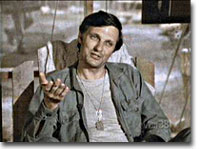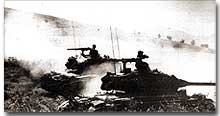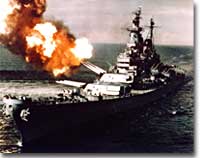52e. The Korean War

The television show "M*A*S*H" aired from 1972-83 and used a Korean War innovation — the Mobile Army Surgical Hospital — as its setting. The show's characters, like Dr. "Hawkeye" Pierce, often addressed the tough issues of war through their interactions.
While many of us have probably seen episodes of the TV show "M*A*S*H," few of us could explain what caused the Korean War. Here's a chance to understand what "Dr. Benjamin Franklin ("Hawkeye") Pierce from Crabapple Cove, Maine, was doing in Korea.
Containment had not gone so well in Asia. When the Soviet Union entered the war against Japan, they sent troops into Japanese-occupied Korea. As American troops established a presence in the southern part of the Korean peninsula, the Soviets began cutting roads and communications at the 38th parallel. Two separate governments were emerging, as Korea began to resemble the divided Germany.
Upon the recommendation of the UN, elections were scheduled, but the North refused to participate. The South elected Syngman Rhee as president, but the Soviet-backed North was ruled by Kim Il Sung. When the United States withdrew its forces from the peninsula, trouble began.
Northern Korean armed forces crossed the 38th parallel on June 25, 1950. It took only two days for President Truman to commit the United States military to the defense of southern Korea. Truman hoped to build a broad coalition against the aggressors from the North by enlisting support from the United Nations.

North Korean tanks cross the 38th Parallel, marking the opening salvo of the Korean War.
Of course, the Soviet Union could veto any proposed action by the Security Council, but this time, the Americans were in luck. The Soviets were boycotting the Security Council for refusing to admit Red China into the United Nations. As a result, the Council voted unanimously to "repel the armed attack" of North Korea. Many countries sent troops to defend the South, but forces beyond those of the United States and South Korea were nominal.
The commander of the UN forces was none other than Douglas MacArthur. He had an uphill battle to fight, as the North had overrun the entire peninsula with the exception of the small Pusan Perimeter in the South. MacArthur ordered an amphibious assault at Inchon on the western side of the peninsula on September 15.
Caught by surprise, the communist-backed northern forces reeled in retreat. American led-forces from Inchon and the Pusan Perimeter quickly pushed the northern troops to the 38th Parallel — and kept going. The United States saw an opportunity to create a complete indivisible democratic Korea and pushed the northern army up to the Yalu River, which borders China.

The USS Missouri fires on Chongjin, North Korea, in October 1950. The mission of this particular engagement was to disable enemy communications systems.
With anticommunism on the rise at home, Truman relished the idea of reuniting Korea. His hopes were dashed on November 27, when over 400,000 Chinese soldiers flooded across the Yalu River. In 1949, Mao Tse-tung had established a communist dictatorship in China, the world's most populous nation. The Chinese now sought to aide the communists in northern Korea.
In no time, American troops were once again forced below the 38th Parallel. General MacArthur wanted to escalate the war. He sought to bomb the Chinese mainland and blockade their coast.
Truman disagreed. He feared escalation of the conflict could lead to World War III, especially if the now nuclear-armed Soviet Union lent assistance to China. Disgruntled, MacArthur took his case directly to the American people by openly criticizing Truman's approach. Truman promptly fired him for insubordination.
Meanwhile, the war evolved into a stalemate, with the front line corresponding more or less to the 38th Parallel. Ceasefire negotiations dragged on for two more years, beyond Truman's Presidency. Finally, on July 27, 1953, an armistice was signed at Panmunjom. North Korea remained a communist dictatorship, and South Korea remained under the control of Syngman Rhee, a military strong man. Over 37,000 Americans were killed in the conflict.
[Note: For decades after the war, the accepted figure for American Korean War deaths was 54,246. In 1993, the 50th anniversary of the end of the war, the Department of Defense (DoD) issued a statement clarifying that this figure represented all deaths of U.S. military personel worldwide during the war, and not only casualties of the war. The DoD stated that 17,730 deaths during this period were not related to the war in Korea]






